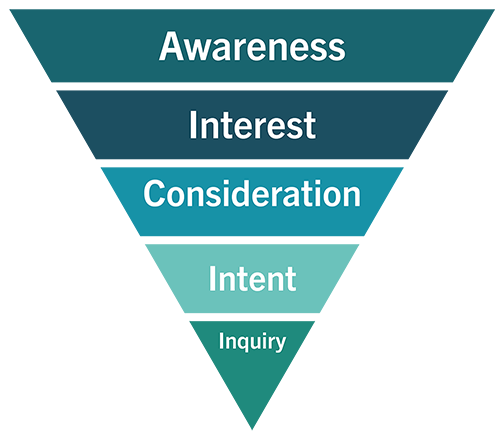
Rethinking The Enrollment Funnel For Higher Ed
The enrollment funnel is a time-honored marketing concept. It defines a sequence of events a prospective student goes through before reaching an enrollment decision. However, the current college market demands we rethink how colleges and universities can best nurture prospective students through the funnel and into the classroom — while prioritizing their marketing and recruitment efforts to do so as cost-effectively as possible.
Mega Universities’ impact on enrollment
Overall enrollment declines have shrunk the number of available prospects and made them harder to convert to registered students. However, from 2011 to 2021, the top 5 mega universities added more than 400K students. How? Online options and aggressive growth from these mega universities have weakened the geographic moats that once defined prime markets for non-national schools.
400,000
The number of students added by the top 5 mega universities between 2011 and 2021
Yet, our experience working with dozens of partners to launch and grow online programs continues to show that a sizable portion of your online enrollment will reside within 50 miles of your institution — and that’s where you should focus your efforts. Spend more time with the prospects you have by thinking beyond list buys and large paid media investments to uncover the ROI of mid-funnel activities.
Focus on middle of funnel through digital marketing
Today’s prospects are carefully weighing their options. They are looking closely at cost and how they’ll finance their education. They are considering practical realities, such as which programs are likely to result in stable job opportunities later. And many are forgoing their top college choices in lieu of less expensive options. All of which happens during the consideration phase of the enrollment funnel.
Prospects who are in the mid-funnel consideration phase have already expressed interest and are ready to engage with you — and colleges that nurture these high-potential prospects have greater success in meeting enrollment goals. And because prospects get to know more about your institution (and vice versa), you’re more likely to enroll “right-fit” students. These goals are achieved through integrating the college’s marketing and admissions teams to create a multi-layered activity approach.
Schools should leverage digital channels to reach and engage with prospective students where they are, such as social media, email, search engines, livestreaming, online advertising, web content and more. Then, use data and marketing insights to help your admissions team craft relevant, purposeful outreach plans that encourage positive associations with your brand.
Elongating the enrollment funnel
The enrollment funnel has typically been separated into several stages: awareness, interest, consideration, intent and inquiry. But it’s a misconception to think the marketing funnel stops at the point of inquiry. That’s not the end of the journey from the student’s point of view.

The recruitment phase
Inquiry is the beginning of the recruitment phase, a period that demands an equal commitment to outreach and engagement and deserves an elongated understanding of the funnel:

Rethink outreach and engagement in higher ed
Marketing can extend its impact beyond the inquiry phase by focusing on:
- Prospect Experience
- Continued Engagement via Marketing Automation
- Personalization
- Retargeting
- Data Enablement
In assigning activities to new funnel phases, keep in mind the effectiveness and suitability of a channel to each phase of the funnel.
Considerations for your in-house infrastructure
To sustain engagement throughout an elongated funnel, your organizational structure and digital marketing strategies may need to evolve, including:
- Running marketing efforts alongside recruitment
- Adopting measurement systems to cover the period from inquiry to start
- Identifying which channels are best suited to engagement at each stage
- Determining how to structure your portfolio of channels to get the best performance
Invest in a balanced marketing mix
Channels have a different invest and return profile, with the lasting investment impact captured by the annuity effect (in other words, the long-term pay-off of a marketing expenditure). Focusing too much on paid media misses the higher end of the funnel, which represents an important area of investment in for future terms.
For example, at the “strong” end of the annuity scale is the school’s website, which can provide a continual stream of high-potential, organic prospects if properly maintained. At the “weak” end of the annuity scale are paid search and display advertising. These are best for top-of-funnel awareness building but are short-lived in effect.
| CHANNEL | TARGETING | ANNUITY EFFECT |
| Digital Marketing | Versatile | Varies |
| Website/Organic Search | High to Mid Funnel | Strong |
| Corporate Relationships | All | Strong |
| PR/Organic Social | PR/Organic Social | Moderate |
| Alumni Referrals | High to Mid Funnel | Moderate |
| Paid Search (Program Level) | Mid Funnel | Weak |
Like an investment portfolio, a college’s marketing mix should be diversified, balancing paid and organic, top-, mid- and bottom-of-funnel channels, and capturing annuity effect where possible. And like investments, the mix should be frequently evaluated on performance and rebalanced when needed.
As you consider your marketing mix, and assignment of channel to where it best performs and has the greatest annuity value, digital marketing should play a major role.
Summary: A fresh take on the enrollment funnel
As the college market matures, schools will need to adjust tactics to continue to capture their share of prospective students.
Elongating the funnel and extending marketing outreach through enrollment maintains engagement all the way down the funnel.
Rather than being a primary channel, paid media needs to take its place alongside organic channels and play an appropriate role in the marketing mix, justified by performance.
Focus on the mid funnel catches prospects in the pivotal consideration phase.
Balancing marketing mix like an investment portfolio ensures investments are appropriate at every stage of the funnel.
Innovation Starts Here
Higher ed is evolving — don’t get left behind. Explore how Collegis can help your institution thrive.